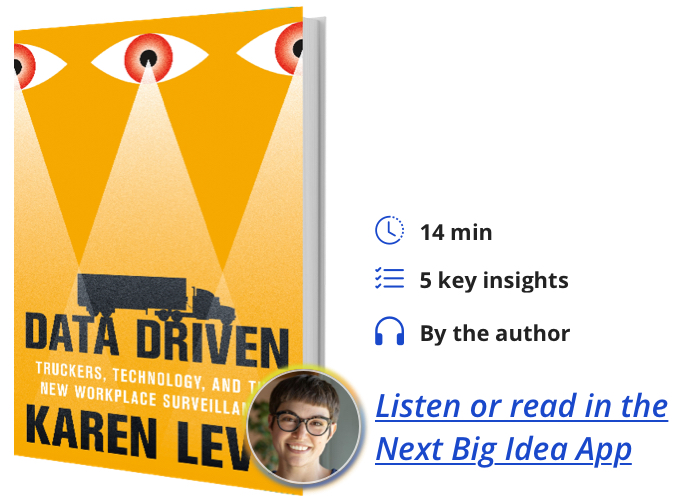Karen Levy is a sociologist, lawyer, and associate professor of information science at Cornell University. She studies the social, legal, and ethical consequences of data-intensive technologies.
Below, Karen shares 5 key insights from her new book, Data Driven: Truckers, Technology and the New Workplace Surveillance. Listen to the audio version—read by Karen herself—in the Next Big Idea App.

1. Surveillance in the workplace has deep roots—but it’s also changing in important ways.
It’s common these days to hear people talk about the “future of work”—but the future of work is in many ways not entirely different from work’s past or present. Managers have tried to keep a close eye on workers ever since managers have existed. The idea that firms want to closely observe and measure what workers are doing isn’t really new. This has been the case basically since the advent of contemporary industry, and firms have done so in the name of goals like efficiency, productivity, and profit.
We also know that new workplace technologies tend to disproportionately harm workers who are at the lower end of the spectrum socioeconomically and they deepen wage inequality. This phenomenon is called skill-biased technological change. When we think about the future of work, we have to keep in mind that some of this is part of a much longer history.
But there are also some things that are changing. As new monitoring technologies, often supported by AI, enter the workplace, there are some important shifts happening. For example, we see surveillance entering new kinds of workplaces that previously were able to escape it. An example is long-haul trucking, the primary focus of Data Driven.
We also see more blurring of what counts as a workplace, especially as more people find themselves working from home or in hybrid arrangements post-pandemic. Managers are relying more on digital tools to keep an eye on what those workers are doing. We see managers drawing on new kinds of data, including wearable devices and biometrics like eye trackers that very finely measure workers’ movements and what they’re paying attention to. We are also seeing more surveillance of workers’ communications, as people tend to talk more through digital platforms rather than face to face.
“We see surveillance entering new kinds of workplaces that previously were able to escape it.”
We see new kinds of analysis, particularly predictive analytics that aim to forecast what workers are likely to do in the future—whether that’s making a particular sale to a particular kind of customer, asking for a raise, or looking around for another job.
Finally, we see new kinds of entanglements as managers increasingly are interested in gathering data about aspects of workers’ lives other than what happens on the job per se—like their social media activity, or how often they spruce up their resumes on LinkedIn, which can indicate that they plan to look for a new job. To sum up, there are aspects of workplace surveillance that are part of this long history, and managers’ goals in surveilling workers haven’t changed all that significantly. The technologies they have at their disposal, however, do mean that workplace surveillance is changing and expanding in some important ways.
2. The open road isn’t nearly as open as it seems.
I started studying long-haul trucking about ten years ago, and one of the questions I’d always ask truckers is what attracted them to trucking as a job. With remarkable consistency, truckers have told me that they got into trucking because they didn’t want someone looking over their shoulder all the time. They liked the freedom and autonomy to make their own day-to-day decisions about how to get their work done. They liked the idea of seeing new parts of the country far from home. There’s a romance about the idea of the open road that really appeals to people, and that motivates them to do work that is dangerous, grueling, and exhausting.
Trucking is, by pretty much all objective measures, a bad job—some even compare it to sweatshop labor in terms of the number of hours truckers work, the low wages they get for their work, and the amount of physical risk they experience every day. But it’s also a job that people are really proud to take part in. Trucking is not just an occupation, it’s an identity.
We like to talk a lot about essential workers these days, and truckers are about as essential as it gets. There’s a saying in the industry: “if you got it, a truck brought it.” If you look around and take stock of the room you’re in, or the clothes on your body, nearly all of it was, at one point or another, on a truck being driven down a highway by a trucker. They touch nearly everything in our lives. In the digital age their work is even more important, as we all have come to expect fast delivery of our Amazon shipments, and we want to know exactly where our packages are and when they’ll reach our doorsteps.
Despite the promises of freedom and autonomy, truckers find themselves under a significant and increasing amount of surveillance. Since 2017, the United States government has required long-haul truckers to install digital monitoring devices that track where they are and how much they’re driving. They’ve done this in the name of safety, in order to discourage truckers from driving for longer than they’re legally allowed to—though there’s no evidence that digital monitoring has made the highways safer.
“We like to talk a lot about essential workers these days, and truckers are about as essential as it gets.”
What has happened is that digital monitoring places truckers not only under the eye of the government, but also opens the door to more surveillance by trucking companies. Since companies had to buy these technologies, it became very easy for them to use these systems as a scaffold for additional surveillance of their workers. They use them to keep track of things like how hard truckers are braking, whether they’re changing lanes without signaling, how much fuel they’re using, and much more. They use these metrics to quantify trucking work in new ways, giving drivers scorecards that compare them to their coworkers. It doesn’t end there either. All the data collected about truckers also fuels analytics by insurance companies and by other third-party firms that want to sell products and services, like parking spaces, to drivers.
3. Surveillance doesn’t necessarily make us safer.
Now at this point, you might reasonably say – okay, well, it’s too bad that truck drivers find the surveillance of their work invasive and unpleasant. But you know what? Maybe that’s just what they’ve signed up for! This is a safety-critical situation, these are folks who work on the public roads; thousands of people every year die in truck-related crashes. Maybe surveillance is just the price we have to pay for safety.
The idea that surveillance is a necessary trade-off for more safety or better security is a common belief across lots of different contexts. In many of those contexts though, including trucking, this is actually a misunderstanding. Even on its own terms, surveillance in trucking fails as a safety technology. The best data we have shows that truck crash rates and fatalities went up after electronic surveillance was made mandatory by the government.
One reason is that monitoring means that there’s a lot more rigidity in the timekeeping rules truckers have to follow. If you go over your allowable driving time by even a little bit, this is tracked, and you’re in violation. This is the kind of thing that drivers used to have considerably more flexibility about before it was monitored digitally. Therefore, truckers actually end up driving faster because of this extra rigidity in the system about how long they can drive.
Another thing that happens is that the folks who have been driving trucks for decades—the old hands—are the folks you most want behind the wheel of a truck because they’re the safest. But these are often the most likely to hang up their keys because they don’t want to be monitored in this way. The 18-year-olds who are new to trucking are less likely to object to the surveillance, but are also the drivers you least want to be next to on the highway. Thus, we end up in this sort of counterintuitive place where the very technology that has been deployed in the name of safety actually may be making us all less safe.
4. Automation and surveillance are complements, not substitutes.
While researching trucker surveillance, I noticed how more and more people began to talk about the idea that sometime soon we might not need human truckers at all. Autonomous vehicle technology would essentially make human truckers redundant or obsolete, and many thousands of people working in the industry might soon be out of work entirely.
In the last few years, we’ve seen massive investment in autonomous vehicle technologies. Trucking might well be an industry in need of some sort of disruption—it’s a workplace that’s extremely dangerous, and where fatigue and overwork are tremendous problems. Many people like to point out that robots don’t get tired. However, the more I investigated what autonomous vehicle technology would mean for the trucking industry, the more I came to understand that AI and automation don’t substitute for the heavy surveillance of human workers. Autonomous vehicle technology is nowhere near ready to replace these workers. Even most state-of-the-art technology still requires a human being to be in the truck cab and paying attention to the road in order to take over from the machine if needed at very short notice.
“Trucking might well be an industry in need of some sort of disruption—it’s a workplace that’s extremely dangerous, and where fatigue and overwork are tremendous problems.”
It turns out that humans are incredibly bad at doing this sort of “machine minding.” We’re just not cognitively built to monitor a safety-critical system passively for a long time, and we tend not to be very good at it. But in order to keep humans alert and awake, what we actually see happening in the industry is that AI is being used to complement the surveillance truckers already find themselves subjected to. For example, companies market camera systems augmented by AI which detect if a driver’s eyelids are fluttering or his head is nodding, both signs of fatigue. When this happens, the system might sound an alarm or flash lights in his eyes to wake him back up. Wearable devices can monitor a driver’s heartbeat or brain waves to look for signs of irregularity.
AI is not currently displacing human beings from the truck, as people often fear. Instead, it’s joining them there in this very intimate way, turning them into cyborgs in a sense. This suggests that when we think about automation and work, it’s not enough just to think about quantity, about how many jobs the robots might take; we also have to ask about the quality and dignity of the work that remains.
5. When we use technology to solve a problem, we may actually be avoiding solving a different, bigger problem.
One important thing to recognize is that very frequently, when it seems like there’s a lot of excitement about using technology to solve a problem, what is really happening is that we are avoiding addressing a different problem. Technology is sort of like digital duct tape—sometimes we use it to hold a system together. In the best case scenario it maybe might help us hold things together a bit longer, but it ultimately isn’t addressing the root causes that led the system to fall apart in the first place.
We see this all over the place when we see technological innovation—in education, in criminal justice, and many other contexts. Many of the technologies we develop and deploy are covering up for an economic or social or political problem. For example, in trucking, the reason we worry about truckers working too much has to do with the pay structure of the industry. Truckers are paid by the mile, which means that they’re incentivized to stay on the road as much as possible, and they’re unpaid for big parts of their workday when they’re waiting to be loaded or unloaded, or when they’re stuck in traffic or bad weather. Truckers are also exempt from the Fair Labor Standards Act, the federal law that gives most workers overtime and other workplace protections. These and other reasons are the root causes of overwork and fatigue in the industry, and there are economic and political solutions to these problems. We could reform the pay structure of trucking or grant truckers legal protections to ensure that they aren’t working themselves to death. Instead, we’ve chosen to use technology as a stopgap without addressing root causes.
This suggests that when we think about technology policy, we should always ask whether the technology is at the rightful center of the policy, or if it’s actually an indicator that there are broader social or economic reforms that are really needed.
To listen to the audio version read by author Karen Levy, download the Next Big Idea App today:































